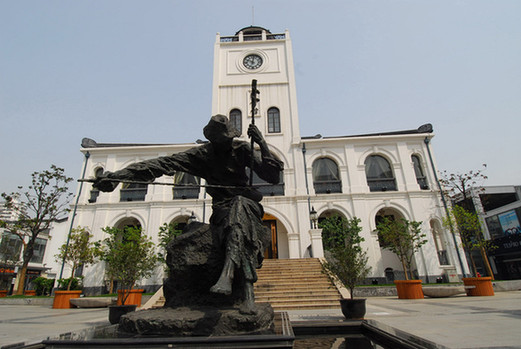 |
|
A statue of Hua Yanjun (A'Bing) playing the Erhu was erected in downtown Wuxi, Jiangsu province. [Photo/ rednet.cn] |
The Moon Reflected on the Er-quan Spring (Erquan Yingyue) is a score of Erhu music composed by blind folk musician Hua Yanjun, known colloquially as A'Bing, in Wuxi in 1949.
The piece enjoys a famous reputation in China and abroad for being a beautiful melody and for having a touching story behind it. In 1985, the music topped the list of the 10 most popular Chinese musical works in the Unites States.
Influenced by his father, Hua Qinghe, a Taoist priest and expert in Taoist music, A'Bing mastered varied national instruments from an early age. His father taught him drums at the age of 10, and by 12, he had learnt how to play Chinese flutes, lutes and Erhu.
When his father died in 1914, A'Bing and his cousin assumed charge of the Taoist temple. However, after operations at the temple took a turn for the worst, A'Bing developed a drug addiction and fell into poverty, resulting in the loss of his eyesight.
Playing Erhu music became an outlet for bitter feelings harbored towards poverty and blindness in A'Bing's adulthood, and he would perform every afternoon in a public square in Wuxi.
The Moon Reflected on the Er-quan Spring was composed beside Hui Spring, which is found in today's Xihui Park in Wuxi. From then on, A'Bing would play the music while walking through the streets of Wuxi as a street busker.
As the song grew more famous locally, two professors from the Central Conservatory of Music, Yang Yinliu and Cao Anhe, both Wuxi natives, helped A'Bing record in 1950 and invited him to teach at the school. However, suffering with illness, A'Bing was unable to work. In August of that year, during a concert in his native Wuxi, A'Bing played the music for the last time, before his death on December 4.
Less than a year after his passing, The Moon Reflected on the Er-quan Spring was broadcast on Tianjin Radio Station, and the piece quickly gained notoriety across China. In 1959, the China International Culture Association presented the musical piece to foreign guests during the country's 10th National Day celebrations.
The song has since been made into a ballet, telling the story of a Chinese folk artist called Brother Quan and an old violinist's daughter called Yue'er. Brother Quan falls in love with Yue'er but is stopped by the vicious Gu family. Yue'er sinks into the bottom of the lake, bereft of love, making Brother Quan so desperate that he blinds his eyes. The ballet production is considered one of the most foremost and treasured in China.
Ozawa Seiji, one of the greatest East Asian conductors of all time, burst into tears when heard the Erhu music in 1978, saying that "one can appreciate it only on bended knees".
A'Bing has been referred to as the "Beethoven of China" and his music, "Chinese Fate Symphony". Francois Mitterrand, former President of France, was particularly fond of the Erhu piece during his lifetime.
A bronze statue of Hua Yanjun was erected in downtown Wuxi in memory of the composer, while his tomb can be found in Xihui Park. A'Bing's family home was the victim of floodwaters in 1991. It was rebuilt in 1993 and is now a memorial to A’Bing and his numerous musical achievements.
For a scholar focusing on Australia's public diplomacy, working as a recreational manager in China may never be part of his career path. But Bradley McConachie does have lots to say now about his special experience at a resort in the picturesque tropical coastal city of Sanya in South China's Hainan province.

One of the potentially most traumatic things a girl has to go through is finding a new hairdresser.